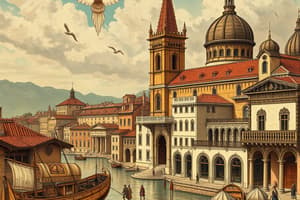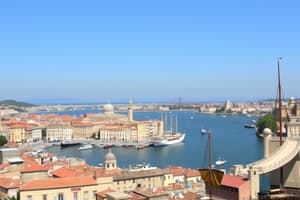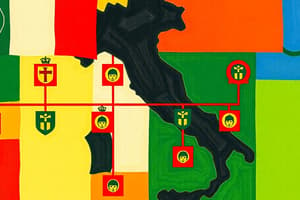Podcast
Questions and Answers
What factor contributed to the decline of Bruges as a major trading port in the fifteenth century?
What factor contributed to the decline of Bruges as a major trading port in the fifteenth century?
- Silt accumulation in the port (correct)
- Escalating conflicts with local merchants
- Increase in trade routes to the east
- Rivalry from emerging city-states
Which of the following goods did the Hansa primarily trade during its peak?
Which of the following goods did the Hansa primarily trade during its peak?
- Electronics and machinery
- Cotton and textiles
- Timber and metals (correct)
- Silk and spices
In what century did the economic crossroads of Europe shift from Bruges to larger territorial states?
In what century did the economic crossroads of Europe shift from Bruges to larger territorial states?
- Seventeenth century
- Sixteenth century (correct)
- Fourteenth century
- Fifteenth century
Which group faced new restrictive pressures on their trade during the period discussed?
Which group faced new restrictive pressures on their trade during the period discussed?
What event greatly impacted the trading dynamics in the sixteenth century?
What event greatly impacted the trading dynamics in the sixteenth century?
What impact did the plague have on the commercial preeminence of the Italians?
What impact did the plague have on the commercial preeminence of the Italians?
Which of the following statements accurately reflects the relationship between the Venetian Flanders Fleet and the Hanseatic League?
Which of the following statements accurately reflects the relationship between the Venetian Flanders Fleet and the Hanseatic League?
What type of food does the third course of the banquet menu primarily consist of?
What type of food does the third course of the banquet menu primarily consist of?
Which of the following best characterizes the purpose and significance of the Hanseatic League by 1500?
Which of the following best characterizes the purpose and significance of the Hanseatic League by 1500?
What does the elaborate banquet menu reveal about the material culture of the Renaissance society?
What does the elaborate banquet menu reveal about the material culture of the Renaissance society?
Flashcards are hidden until you start studying
Study Notes
Trade Dynamics in the Mediterranean and Northern Europe
- Flourishing commerce throughout the Mediterranean expanded north along the Atlantic seaboard.
- Venetian Flanders Fleet's galleys established a direct sea route to England and the Netherlands.
- Italian merchants encountered the powerful Hanseatic League, impacting trade dynamics.
- The plague significantly weakened Italian commercial dominance while the Hanseatic League thrived.
Renaissance Banquet Cuisine
- Banquet menus featured luxurious dishes, indicating high social status.
- Courses included:
- Hot foods: stuffed geese, boiled veal, young calf, stewed pigeons, various pies, and fricasseed goat.
- Delicacies: bean tarts, quince and pear pastries, cheeses, and cakes.
- The diversity and richness of the menu reflect material culture and social stratification during the Renaissance.
The Hanseatic League
- Formed in the thirteenth century by North German coastal towns for trade and military support.
- By 1500, over eighty cities were part of the League, controlling major trade routes in northern Europe.
- Monopoly on essential goods: timber, fish, grain, metals, honey, and wines.
- Bruges, the League's southern outlet, was a key trade hub until port silting caused its economic decline.
Economic Shifts in Trade
- The fourteenth century saw a recovery from economic contraction, revitalizing trade.
- Despite pressures from the Ottoman Turks, Venice maintained a wealthy commercial empire in the Mediterranean.
- The rise of territorial states in the sixteenth century prioritized transatlantic discoveries, challenging the dominance of Italian city-states.
Studying That Suits You
Use AI to generate personalized quizzes and flashcards to suit your learning preferences.




